Performance Analysis of a H-Darrieus Wind Turbine for a Series of 4-Digit NACA Airfoils
Abstract
1. Introduction
2. Rotor Aerodynamic Performance
3. Numerical Model
3.1. Geometric Modeling
3.2. Numerical Settings
3.3. Computational Mesh
3.4. Mesh Sensitivity Study
3.5. Initial Condition Effects
4. Model Validation
4.1. RANS Approach Validation Based on Measured Static Data for NACA 0018
4.2. Instantaneous Aerodynamic Blade Loads
5. Results and Discussion
5.1. Aerodynamic Loads on a Rotor Blade for Symmetrical 4-Digit NACA Airfoils
5.2. Aerodynamic Blade Loads for Cambered 4-Digit NACA Airfoils
5.3. Aerodynamic Wake for Symmetrical and Cambered 4-Digit NACA Airfoils
6. Conclusions
- Steady-state simulations confirmed that the numerical model and computational mesh give reasonable results of aerodynamic force coefficients, lift, and drag components. ANSYS Fluent, Release 17.1 better predicts the relationship between lift and angle of attack, while XFoil gives a slightly better result of a minimum drag coefficient compared to the experiment. Other numerical codes, like FLOWer CFD and vortex model, have shown that ANSYS Fluent CFD code correctly estimates the unsteady blade load components of the wind turbine rotor.
- The first transient investigations concerned symmetrical airfoils from NACA 0012 to NACA 0021. When considering a wind turbine equipped with symmetrical NACA 0018 airfoils, the best aerodynamic performance was observed in the majority of tip speed ratio ranges.
- Although the NACA 0012 airfoil has the largest maximum lift coefficient of all symmetrical airfoils tested, it gives the worst results of the tangential blade load in the low tip speed ratio range. This is due to the worse airfoil characteristics in the detachment area compared to thicker airfoils.
- The analysis showed that symmetrical airfoils are much worse at low tip speed ratios. This is because of the worse characteristics of these airfoils in the stall regime. The introduction of one percent maximum camber greatly improves the aerodynamic performance of the rotor over the entire tip speed ratio range.
- The effect of the relative airfoil thickness on the characteristics of aerodynamic blade load components is larger at low tip speed ratios, whereas the maximum camber affects more of these characteristics at higher tip speed ratios.
- The use of cambered airfoils should improve the dynamic properties of the structure, e.g., reduce vibration. In the case of the NACA 4418 airfoil, the ratio of the maximum tangential blade load for the upwind part of the rotor to the downwind part is 88% lower compared to the NACA 0018 airfoil.
- The study examined the impact of tip speed ratio on the velocity distribution in the aerodynamic wake of a rotor equipped with NACA 0018 airfoils. Numerical analysis showed that as the tip speed ratio increases, and there is a linear decrease in the average velocity Vx (velocity component parallel to the wind direction) of these profiles. In the case of the transverse velocity component Vy, its average for each tip speed ratio value is very close to zero. In the case of a rotor equipped with the symmetrical profile NACA 0018, it was observed that the share of the velocity component Vy in the aerodynamic shadow of the rotor is very low in the entire tested tip speed ratio range.
- The increase in the relative thickness of symmetrical airfoils does not cause significant differences in the velocity distribution downstream behind the rotor in the entire investigated tip speed ratio range. The impact of maximum airfoil camber on the velocity distribution in aerodynamic shadow of the rotor is negligible. As in the case of symmetrical airfoils, the tip speed ratio has the biggest influence on the velocity distribution in the aerodynamic wake downstream behind the rotor.
- Good experimental data is really missing to further validate the low TSR results. More investigation on the influence by the different turbulence models is needed in future work, especially naturally unsteady models, such as LES and detached eddy simulation (DES).
Author Contributions
Funding
Conflicts of Interest
References
- Paraschivoiu, I. Wind Turbine Design: With Emphasis on Darrieus Concept; Presses Internationales Polytechnique: Montréal, QC, Canada, 2002. [Google Scholar]
- Anderson, J.W.; Brulle, R.V.; Bircheld, E.B.; Duwe, W.D. McDonnell 40-kW Giromill wind system: Phase I-Design and Analysis; Technical report; McDonnell Aircraft Company: St. Louis, MO, USA, 1979; Volume 2. [Google Scholar]
- Brulle, R. McDonnell 40-kW Giromill Wind System. Phase II. Fabrication and Test; Technical report; McDonnell Aircraft Co: St. Louis, MO, USA, 1980. [Google Scholar]
- Gipe, P. Wind Energy for the Rest of Us: A Comprehensive Guide to Wind Power and How to Use It; Wind-Works Org: Backersfield, CA, USA, 2016. [Google Scholar]
- Jankowski, K. Vertical Axis Wind Turbine of Darrieus H-Type with Variable Blade Incidence Angle Concept Design. Master’s Thesis, Warsaw University of Technology, Warsaw, Poland, 2009. [Google Scholar]
- Hansen, M. Aerodynamics of Wind Turbines, 3rd ed.; Earthscan: London, UK, 2015. [Google Scholar]
- Shamsoddin, S.; Porté-Agel, F. Large eddy simulation of vertical axis wind turbine wakes. Energies 2014, 7, 890–912. [Google Scholar] [CrossRef]
- Alaimo, A.; Esposito, A.; Messineo, A.; Orlando, C.; Tumino, D. 3D CFD analysis of vertical axis wind turbine. Energies 2015, 8, 3013–3033. [Google Scholar] [CrossRef]
- Bangga, G.; Hutomo, G.; Wiranegara, R.; Sasongko, H. Numerical study on a single bladed vertical axis wind turbine under dynamic stall. J. Mech. Sci. Technol. 2017, 31, 261–267. [Google Scholar] [CrossRef]
- Bangga, G.; Lutz, T.; Dessoky, A.; Krämer, E. Unsteady Navier-Stokes studies on loads, wake, and dynamic stall characteristics of a two-bladed vertical axis wind turbine. J. Renew. Sust. Energ. 2017, 9. [Google Scholar] [CrossRef]
- Li, Q.; Maeda, T.; Kamada, Y.; Hiromori, Y.; Nakai, A.; Kasuya, T. Study on stall behavior of a straight-bladed vertical axis wind turbine with numerical and experimental investigations. J. Wind. Eng. Ind. Aerodyn. 2017, 164, 1–12. [Google Scholar] [CrossRef]
- Rogowski, K.; Maroński, R.; Piechna, J. Numerical analysis of a small-size vertical-axis wind turbine performance and averaged flow parameters around the rotor. Arch. Mech. Eng. 2017, 64, 205–218. [Google Scholar] [CrossRef]
- Rogowski, K. Numerical studies on two turbulence models and a laminar model for aerodynamics of a vertical-axis wind turbine. J. Mech. Sci. Technol. 2018, 32, 2079–2088. [Google Scholar] [CrossRef]
- Rezaeiha, A.; Montazeri, H.; Blocken, B. Towards accurate CFD simulations of vertical axis wind turbines at different tip speed ratios and solidities: Guidelines for azimuthal increment, domain size and convergence. Energy Convers. Manag. 2018, 159, 301–316. [Google Scholar] [CrossRef]
- Wang, Y.; Shen, S.; Li, G.; Huang, D.; Zheng, Z. Investigation on aerodynamic performance of vertical axis wind turbine with different series airfoil shapes. Renew. Energy 2018, 126, 801–818. [Google Scholar] [CrossRef]
- Zhang, L.; Zhu, K.; Zhong, J.; Zhang, L.; Jiang, T.; Li, S.; Zhang, Z. Numerical investigations of the effects of the rotating shaft and optimization of urban vertical axis wind turbines. Energies 2018, 11, 1870. [Google Scholar] [CrossRef]
- Rezaeiha, A.; Montazeri, H.; Blocken, B. CFD analysis of dynamic stall on vertical axis wind turbines using scale adaptive simulation (SAS): Comparison against URANS and hybrid RANS/LES. Energy Convers. Manag. 2019, 196, 1282–1298. [Google Scholar] [CrossRef]
- Rezaeiha, A.; Montazeri, H.; Blocken, B. On the accuracy of turbulence models for CFD simulations of verticalaxis wind turbines. Energy 2019, 180, 838–857. [Google Scholar] [CrossRef]
- Rogowski, K. CFD Computation of the H-Darrieus wind turbine—The impact of the rotating shaft on the rotor performance. Energies 2019, 12, 2506. [Google Scholar] [CrossRef]
- Ishie, J.; Wang, K.; Ong, M.C. Structural dynamic analysis of semi-submersible floating vertical axis wind turbines. Energies 2016, 9, 1047. [Google Scholar] [CrossRef]
- Li, Q.; Kamada, Y.; Maeda, T.; Murata, J.; Okumura, Y. Fundamental study on aerodynamic force of floating offshore wind turbine with cyclic pitch mechanism. Energy 2016, 99, 20–31. [Google Scholar] [CrossRef]
- Bedon, G.; Schmidt Paulsen, U.; Aagaard Madsen, H.; Belloni, F.; Raciti Castelli, M.; Benini, E. Computational assessment of the DeepWind aerodynamic performance with different blade and airfoil configurations. Appl. Energy 2017, 185, 1100–1108. [Google Scholar] [CrossRef]
- Rossander, M.; Dyachuk, E.; Apelfröjd, S.; Trolin, K.; Goude, A.; Bernhoff, H.; Eriksson, S. Evaluation of a Blade Force Measurement System for a Vertical Axis Wind Turbine Using Load Cells. Energies 2015, 8, 5973–5996. [Google Scholar] [CrossRef]
- Bhutta, M.M.A.; Hayat, N.; Farooq, U.A.; Ali, A.; Jamil, S.R.; Hussain, Z. Vertical axis wind turbine—A review of various configurations and design techniques. Renew. Sust. Energ. Rev. 2012, 16, 1926–1939. [Google Scholar] [CrossRef]
- Möllerström, E.; Gipe, P.; Beurskens, J.; Ottermo, F. A historical review of vertical axis wind turbines rated 100 kW and above. Renew. Sust. Energ. Rev. 2019, 105, 1–13. [Google Scholar] [CrossRef]
- Rogowski, K.; Hansen, M.O.L.; Maroński, R.; Lichota, P. Scale adaptive simulation model for the darrieus wind turbine. J. Phys. Conf. Ser. 2016, 753, 022050. [Google Scholar] [CrossRef]
- Balduzzi, F.; Bianchini, A.; Maleci, R.; Ferrara, G.; Ferrari, L. Critical issues in the CFD simulation of Darrieus wind turbines. Renew. Energy 2016, 85, 419–435. [Google Scholar] [CrossRef]
- Healy, J.V. The influence of blade thickness on the output of vertical axis wind turbines. Wind Eng. 1978, 2, 1–9. [Google Scholar]
- Claessens, M.C. The Design and Testing of Airfoils for Application in Small Vertical Axis Wind Turbines. Master’s Thesis, Delft University of Technology, Delft, The Netherlands, 2006. [Google Scholar]
- Kirke, B.; Lazauskas, L. Enhancing the performance if a vertical axis wind turbine using a simple variable pitch system. Wind Eng. 1991, 15, 187–195. [Google Scholar]
- Song, C.; Wu, G.; Zhu, W.; Zhang, X. Study on aerodynamic characteristics of darrieus vertical axis wind turbines with diferent airfoil maximum thicknesses through computational fluid dynamics. Arab. J. Sci. Eng. 2020, 45, 689–698. [Google Scholar] [CrossRef]
- Danao, L.A.; Quin, N.; Howell, R. A numerical study of blade thickness and camber effects on vertical axis wind turbines. Proc. Inst. Mech. Eng. Part A J. Pow. Energy 2012, 226, 867–881. [Google Scholar] [CrossRef]
- Bianchini, A.; Balduzzi, F.; Ferrara, G.; Ferrari, L. Virtual incidence effect on rotating airfoils in Darrieus wind turbines. Energy Convers. Manag. 2016, 111, 329–338. [Google Scholar] [CrossRef]
- Sun, X.J.; Lu, Q.D.; Huang, D.G.; Wu, G.Q. Airfoil selection for a lift type vertical axis wind turbine. J. Eng. Thermophys. 2012, 33, 408–410. [Google Scholar]
- Moran, J. An Introduction to Theoretical and Computational Aerodynamics; Dover Publications INC: New York, NY, USA, 2003. [Google Scholar]
- Shires, A. Design optimisation of an offshore vertical axis wind turbine. Energy 2013, 166, 7–18. [Google Scholar] [CrossRef]
- Tjiu, W.; Marnoto, T.; Mat, S.; Ruslan, M.H.; Sopian, K. Darrieus vertical axis wind turbine for power generation I: Assessment of Darrieus VAWT configurations. Renew. Energy 2015, 75, 50–67. [Google Scholar] [CrossRef]
- Price, T.J. UK large-scale wind power programme from 1970 to 1990: The Carmarthen Bay experiments and the Musgrove vertical-axis turbines. Wind Eng. 2006, 30, 225–242. [Google Scholar] [CrossRef]
- Mays, I.D.; Morgan, C.A.; Anderson, M.B.; Powels, S.J.R. Experience with the VAWT 850 demonstration project. In Proceedings of the European Wind Energy Association Conference, Madrid, Spain, 10–14 September 1990. [Google Scholar]
- Apelfröjd, S.; Eriksson, S.; Bernhoff, H. A Review of Research on Large Scale Modern Vertical Axis Wind Turbines at Uppsala University. Energies 2016, 9, 570. [Google Scholar] [CrossRef]
- Ottermo, F.; Eriksson, S.; Bernhoff, H. Parking strategies for vertical axis wind turbines. ISRN Renewab. Energy 2012. [Google Scholar] [CrossRef]
- Templin, R. Design Characteristics of the 224 kW Magdalen Islands VAWT; National Research Council of Canada: Ottawa, ON, Canada, 1979. [Google Scholar]
- Zhong, J.; Li, J.; Guo, P.; Wang, Y. Dynamic stall control on a vertical axis wind turbine airfoil using leading-edge rod. Energy 2019, 174, 246–260. [Google Scholar] [CrossRef]
- Wong, H.K.; Chong, T.W.; Poh, S.C.; Shiah, Y.; Sukiman, N.L.; Wang, C. 3D CFD simulation and parametric study of a flat plate deflector for vertical axis wind turbine. Renew. Energy 2018, 129, 32–55. [Google Scholar] [CrossRef]
- Elsakka, M.M.; Ingham, D.D.; Ma, L.; Pourkashanian, M. CFD analysis of the angle of attack for a vertical axis wind turbine blade. Energy Convers. Manag. 2019, 182, 154–165. [Google Scholar] [CrossRef]
- Lichota, P.; Agudelo, D. A Priori Model Inclusion in the Multisine Maneuver Design. In Proceedings of the 17th IEE Carpathian Control Conference, Tatranska Lomnica, Slovakia, 29 May–1 June 2016. [Google Scholar] [CrossRef]
- Lichota, P.; Szulczyk, J.; Tischler, M.B.; Berger, T. Frequency Response Identification from Multi-Axis Maneuver with Simultaneous Multisine Inputs. J. Guid. Control. Dynam. 2019, 42, 2550–2556. [Google Scholar] [CrossRef]
- Bianchini, A.; Balduzzi, F.; Ferrara, G.; Ferrari, L.; Persico, G.; Dossena, V.; Battisti, L. Detailed analysis of the wake structure of a straight-blade H-Darrieus wind turbine by means of wind tunnel experiments and CFD simulations. In Proceedings of the ASME Turbo Expo 2017: Turbomachinery Technical Conference and Exposition, Charlotte, NC, USA, 26–30 June 2017. [Google Scholar] [CrossRef]
- Bianchini, A.; Balduzzi, F.; Rainbird, J.M.; Peiro, J.; Graham, J.M.R.; Ferrara, G.; Ferrari, L. An experimental and numerical assessment of airfoil polars for use in Darrieus wind turbines—Part I: Flow curvature effects. J. Eng. Gas. Turbine Pow. 2015, 138. [Google Scholar] [CrossRef]
- Bianchini, A.; Balduzzi, F.; Ferrari, L. Aerodynamics of Darrieus wind turbines airfoils: The impact of pitching moment. J. Eng. Gas. Turbine Pow. 2017, 139, 042602-1-12. [Google Scholar] [CrossRef]
- Mohamed, M.H.; Ali, A.M.; Hafiz, A.A. CFD analysis for H-rotor Darrieus turbine as a low speed wind energy converter. Eng. Sci. Technol. Int. J. 2015, 18, 1–13. [Google Scholar] [CrossRef]
- Hoerner, S.; Abbaszadeh, S.; Maître, T.; Cleynen, O.; Thévenin, D. Characteristics of the fluid–structure interaction within Darrieus water turbines with highly flexible blades. J. Fluid. Struct. 2019, 88, 13–30. [Google Scholar] [CrossRef]
- Ivanov, T.D.; Simonović, A.M.; Svorcan, J.S.; Peković, O.M. VAWT optimization using genetic algorithm and CST airfoil parameterization. FME Transact. 2017, 45, 26–32. [Google Scholar] [CrossRef]
- Tescione, G.; Ragni, D.; He, C.; Ferreira, C.S.; Van Bussel, G.J.W. Near wake flow analysis of a vertical axis wind turbine by stereoscopic particle image velocimetry. Renew. Energy 2014, 70, 47–61. [Google Scholar] [CrossRef]
- Tescione, G.; Ferreira, C.S.; Van Bussel, G.J.W. Analysis of a free vortex wake model for the study of the rotor and near wake flow of a vertical axis wind turbine. Renew. Energy 2016, 87, 552–563. [Google Scholar] [CrossRef]
- Beri, H.; Yao, Y. Effect of Camber Airfoil on Self Starting of Vertical Axis Wind Turbine. Environ. Sci. Technol. 2011, 4, 302–312. [Google Scholar] [CrossRef]
- Mohamed, M.H.; Janiga, G.; Pap, E.; Thévenin, D. Optimal blade shape of a modified Savonius turbine using an obstacle shielding the returning blade. Energy Convers. Manag. 2011, 52, 236–242. [Google Scholar] [CrossRef]
- Ferreira, C.J.S.; Van Zuijlen, A.; Bijl, H.; Van Bussel, G.; Van Kuik, G. Simulating dynamic stall in a two-dimensional vertical-axis wind turbine: Verification and validation with particle image velocimetry data. Wind Energy 2009, 13, 1–17. [Google Scholar] [CrossRef]
- Castelli, M.R.; Englaro, A.; Benini, E. The Darrieus wind turbine: Proposal for a new performance prediction model based on CFD. Energy 2011, 36, 4919–4934. [Google Scholar] [CrossRef]
- Trivellato, F.; Castelli, M.R. On the Courant-Friedrichs-Lewy criterion of rotating grids in 2D vertical-axis wind turbine analysis. Renew. Energy 2014, 62, 53–62. [Google Scholar] [CrossRef]
- Rogowski, K.; Hansen, M.O.L.; Lichota, P. 2-D CFD Computations of the two-bladed Darrieus-type wind turbine. J. Appl. Fluid Mech. 2018, 11, 835–845. [Google Scholar] [CrossRef]
- Rogowski, K.; Hansen, M.O.L. URANS and ACM for determining the aerodynamic performance of vertical-axis wind turbine. In E3S Web of Conferences; EDP Sciences: Les Ulis, France, 2019. [Google Scholar] [CrossRef]
- Menter, F. Two-equation Eddy-Viscosity turbulence models for engineering applications. AIAA J. 1994, 32, 1598–1605. [Google Scholar] [CrossRef]
- Sheldahl, R.E.; Klimas, P.C. Aerodynamic Characteristics of Seven Symmetrical Airfoil Sections Through 180-Degree Angle of Attack for Use in Aerodynamic Analysis of Vertical Axis Wind Turbines; Technical report SAND80-2114; Sandia National Labs: Albuquerque, NM, USA, 1981.
- Drela, M. XFOIL: An Analysis and Design System for Low Reynolds Number Airfoils. In Proceedings of the Conference on Low Reynolds Number Airfoil Aerodynamics, Notre Dame, IN, USA, 5–8 June 1989. [Google Scholar]
- Rezaeiha, A.; Kalkman, I.; Blocken, B. Effect of pitch angle on power performance and aerodynamics of a vertical axis wind turbine. Appl. Energy 2017, 197, 132–150. [Google Scholar] [CrossRef]
- Weihing, P.; Letzgus, J.; Bangga, G.; Lutz, T.; Krämer, E. Hybrid RANS/LES Capabilities of the Flow Solver FLOWer—Application to Flow Around Wind Turbines, Symposium on Hybrid RANS-LES Methods; Springer: Cham, Switzerland, 2016; pp. 369–380. [Google Scholar]
- Kumar, P.M.; Sivalingam, K.; Lim, T.C.; Ramakrishna, S.; Wei, H. Strategies for enhancing the low wind speed performance of H-DarrieusWind turbine—Part 1. Clean Technol. 2019, 1, 32–51. [Google Scholar] [CrossRef]
- Sarraf, C.; Djeridi, H.; Prothin, S.; Billard, J.Y. Thickness effect of NACA foils on hydrodynamic global parameters, boundary layer states and stall establishment. J. Fluids Struct. 2010, 26, 559–578. [Google Scholar] [CrossRef][Green Version]
- Rezaeiha, A.; Montazeri, H.; Blocken, B. Towards optimal aerodynamic design of vertical axis wind turbines: Impact of solidity and number of blades. Energy 2018, 165, 1129–1148. [Google Scholar] [CrossRef]
- Akimoto, H.; Hara, Y.; Kawamura, T.; Nakamura, T.; Lee, Y.-S. A conformal mapping technique to correlate the rotating flow around a wing section of vertical axis wind turbine and an equivalent linear flow around a static wing. Lett. Environ. Res. Lett. 2013, 8. [Google Scholar] [CrossRef][Green Version]
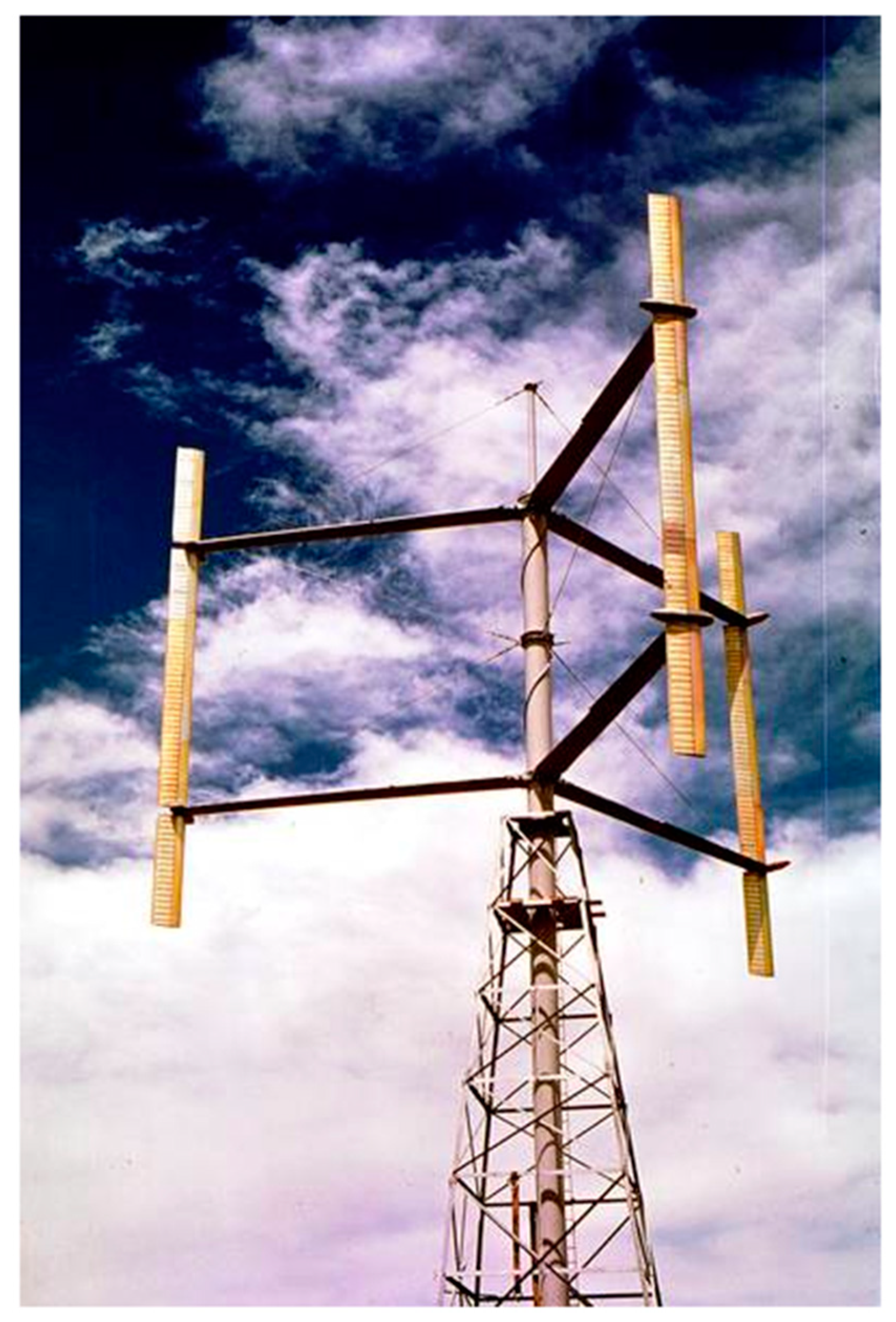
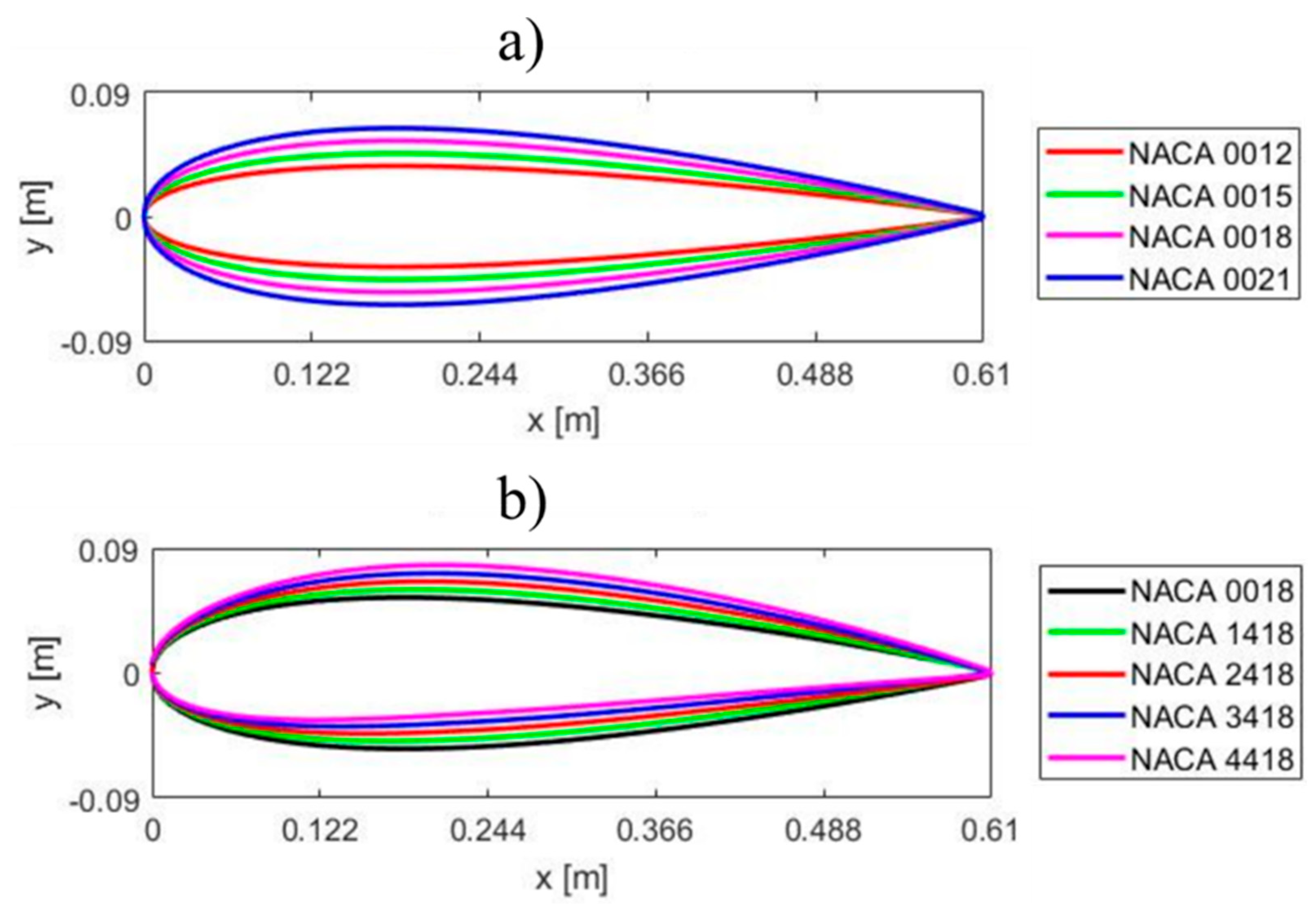
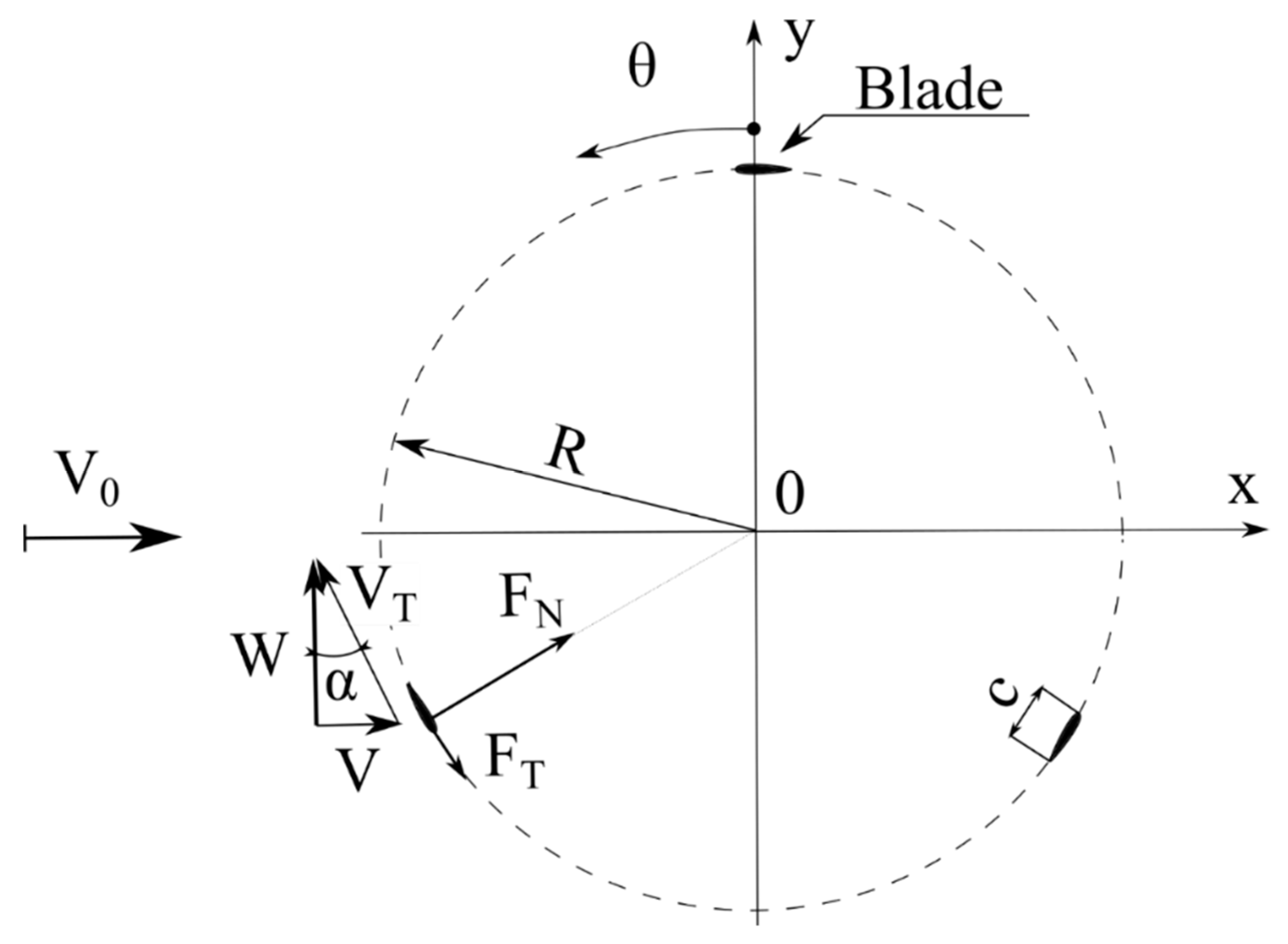
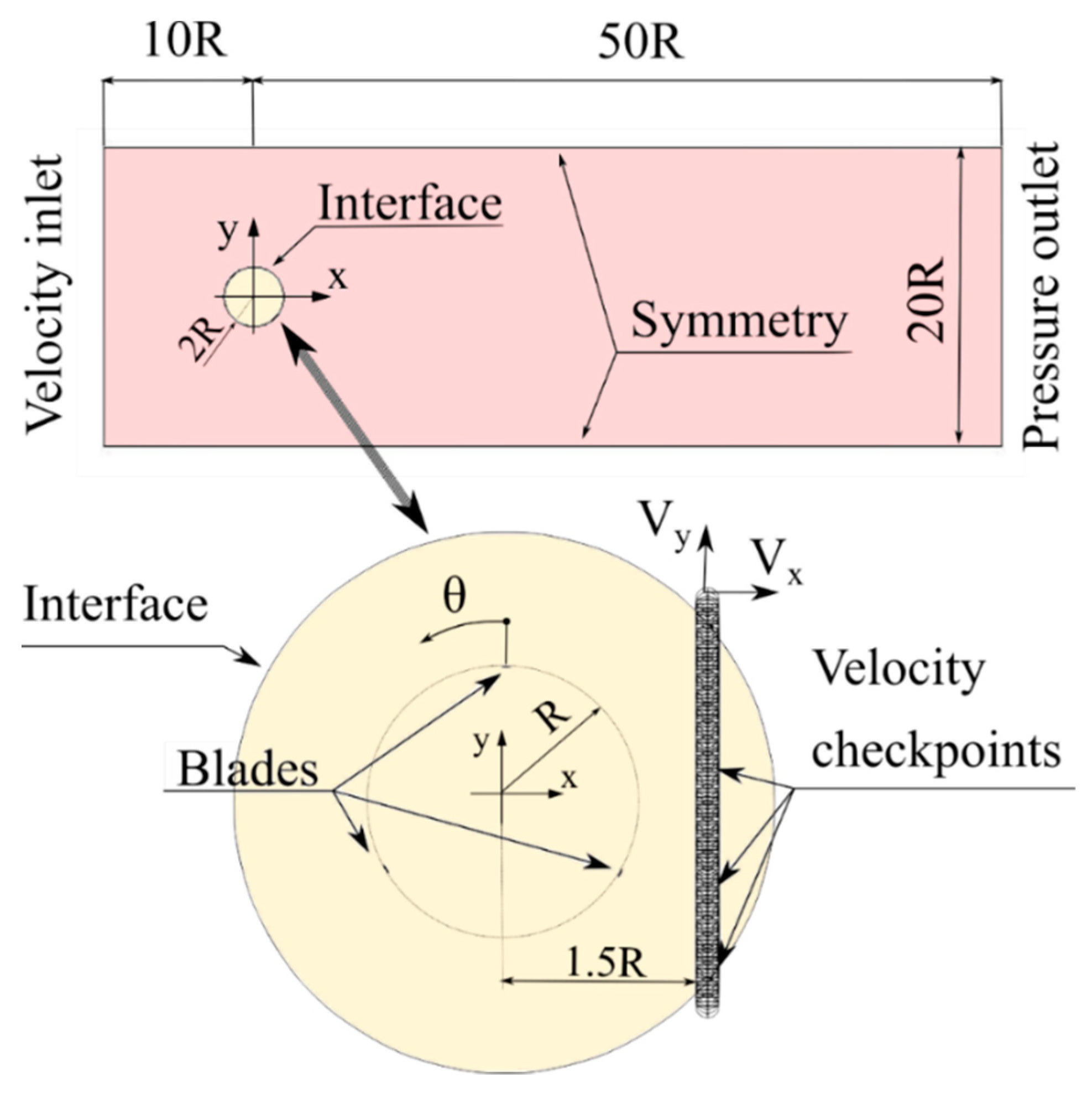
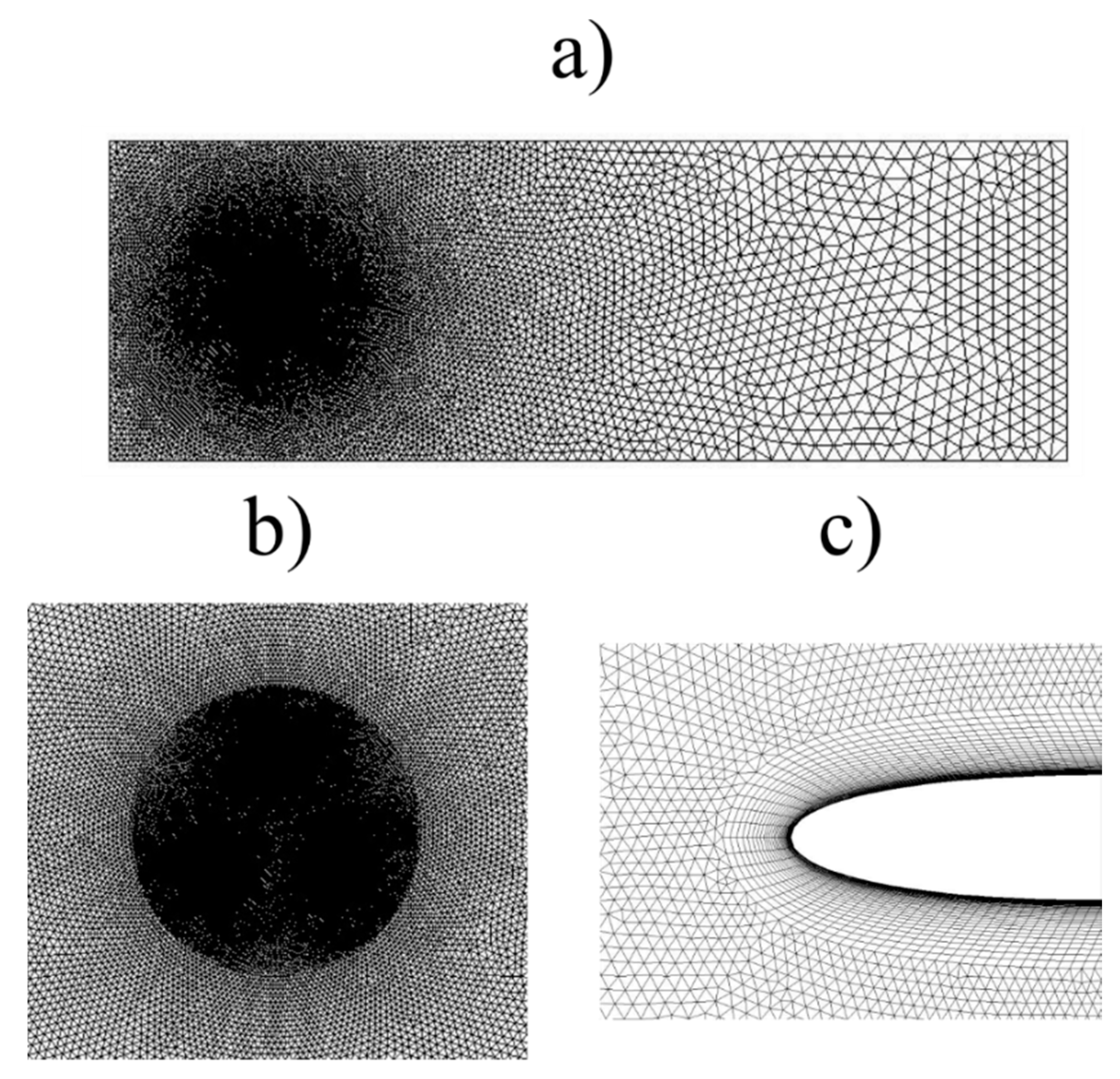
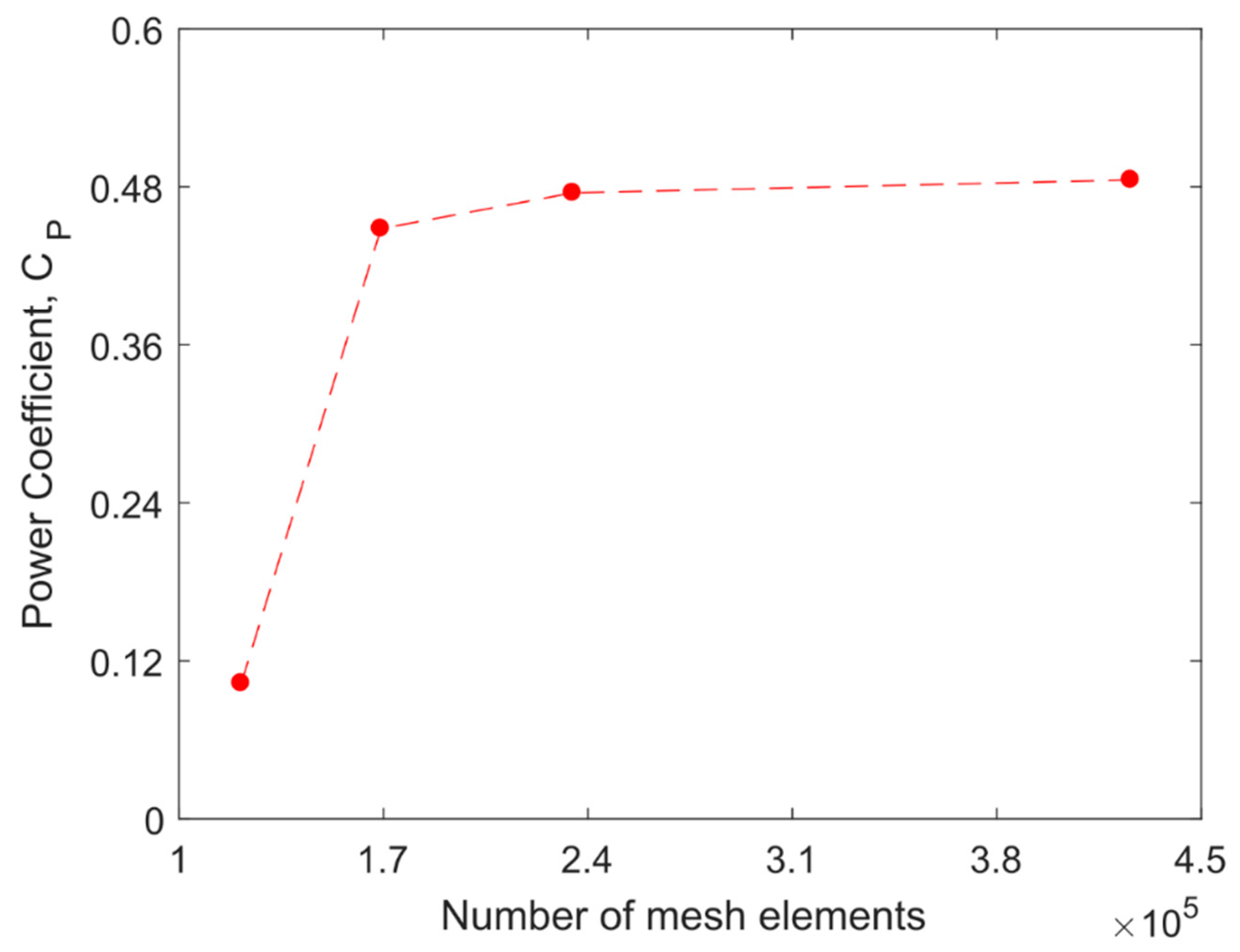
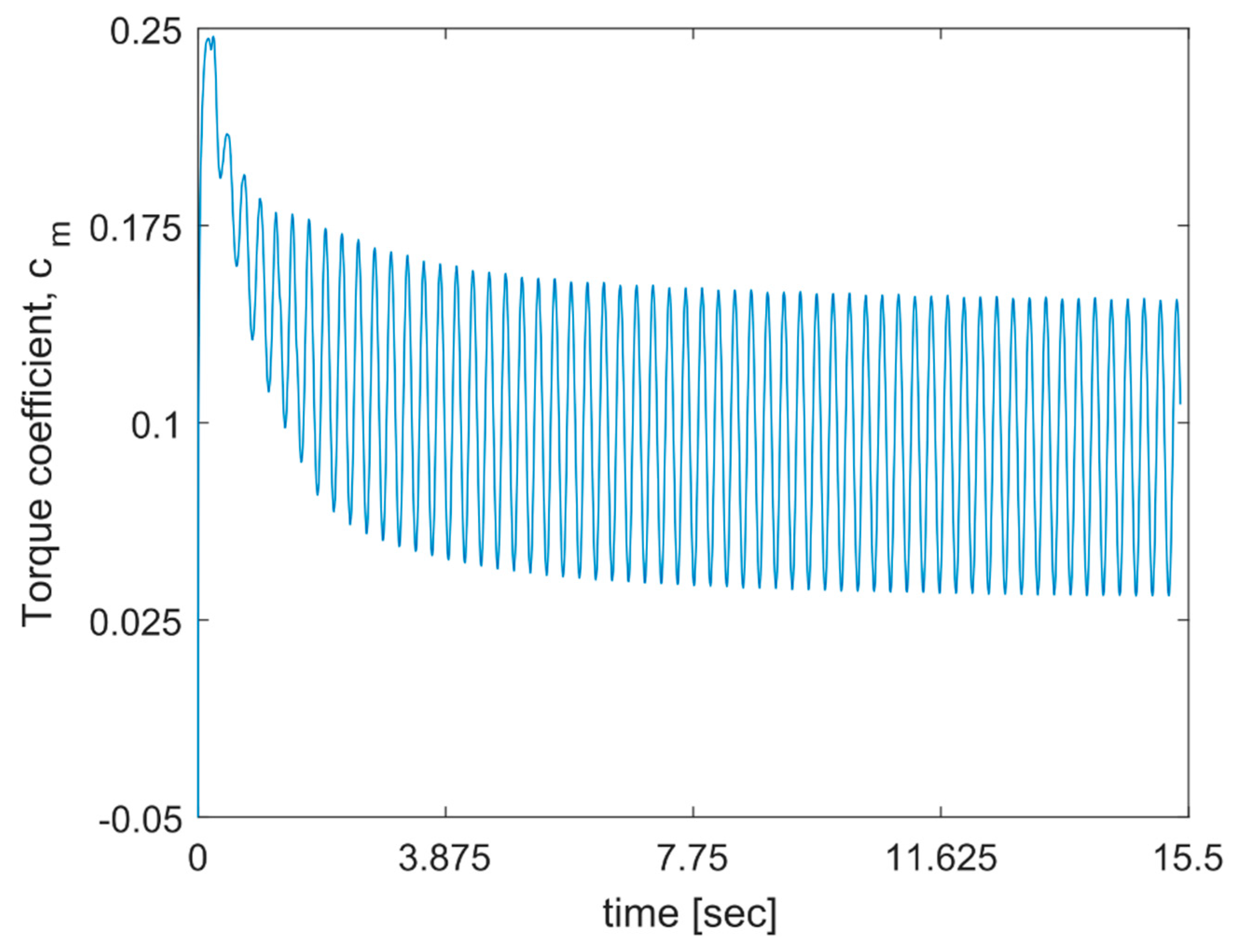
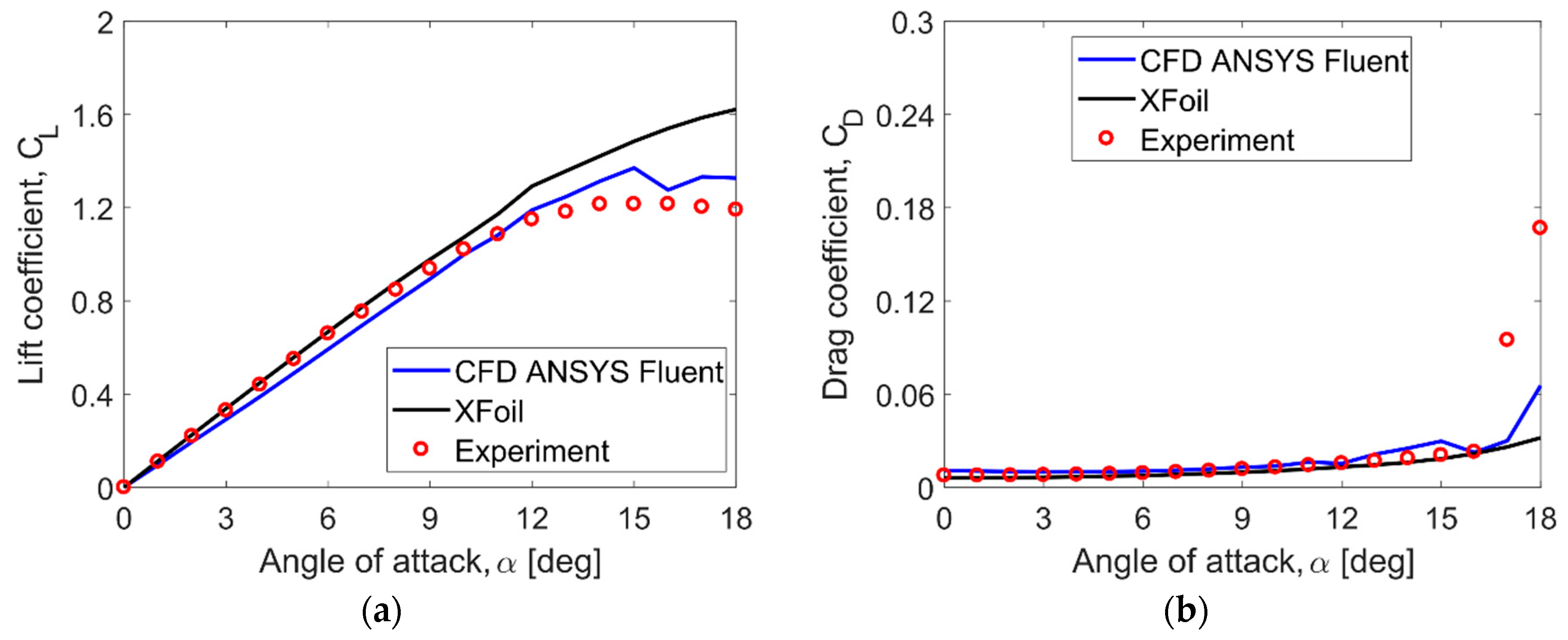
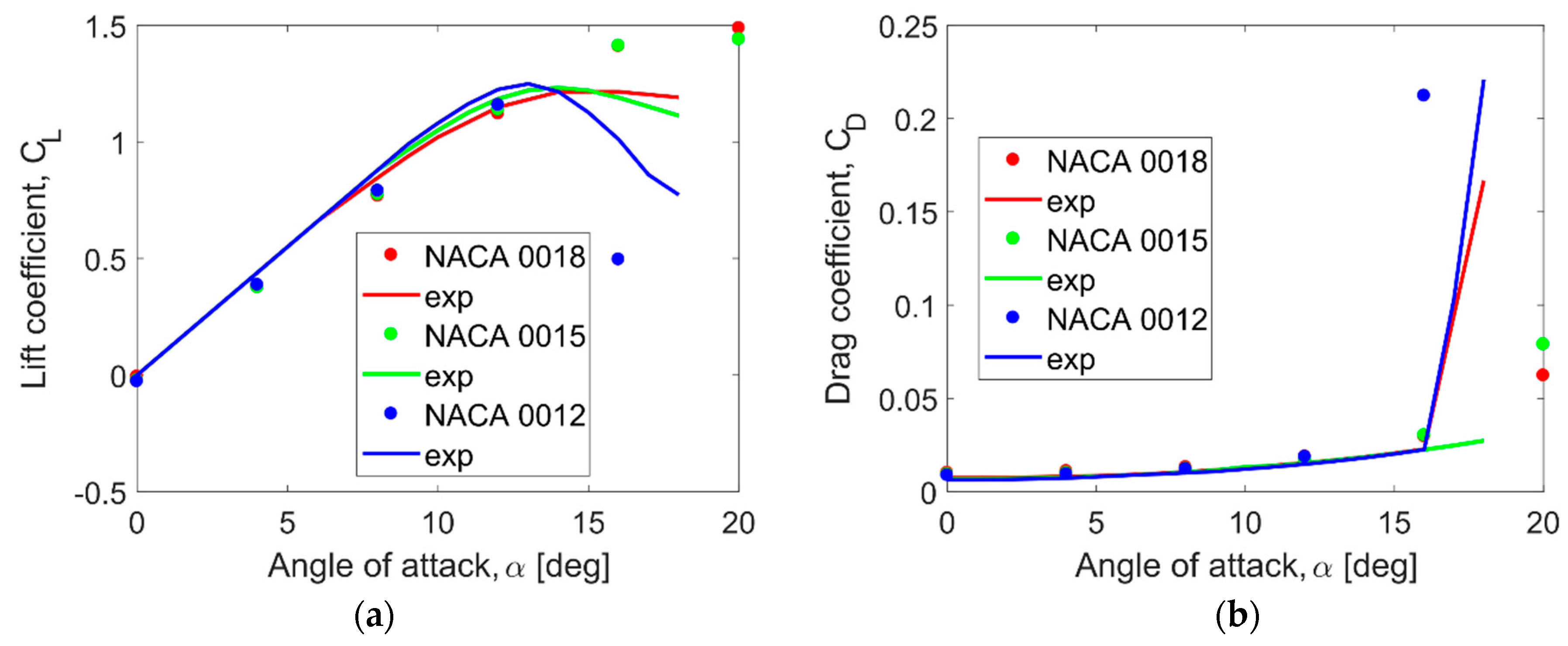
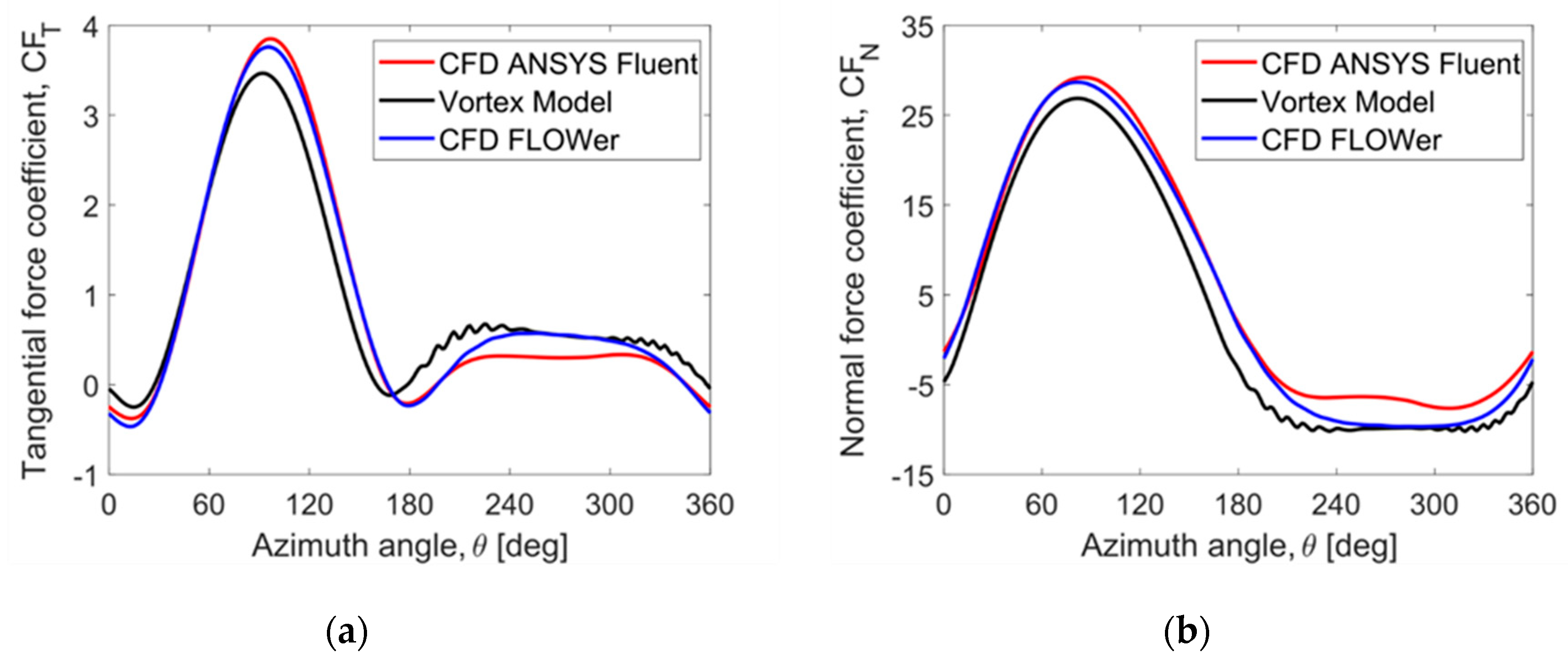
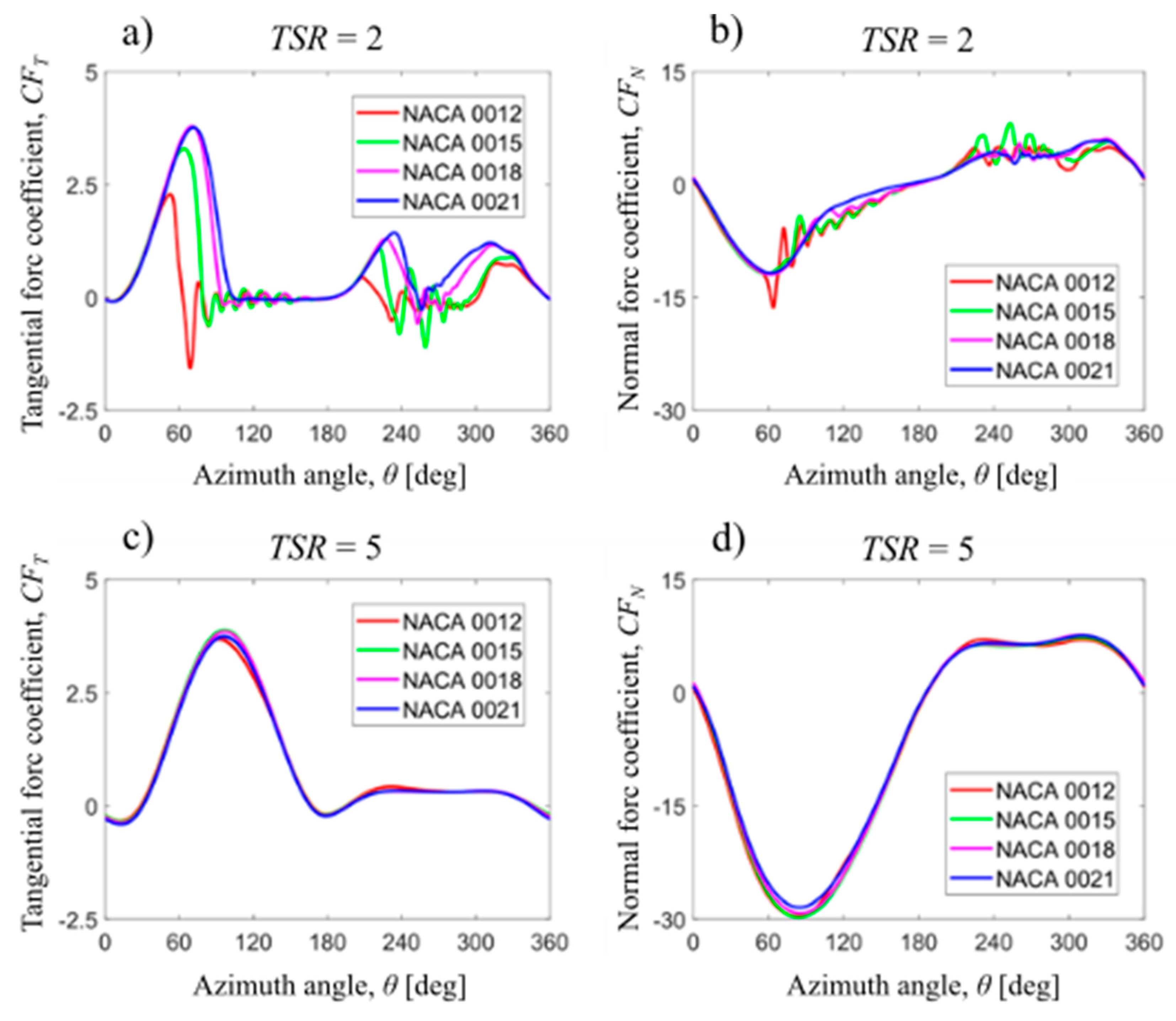
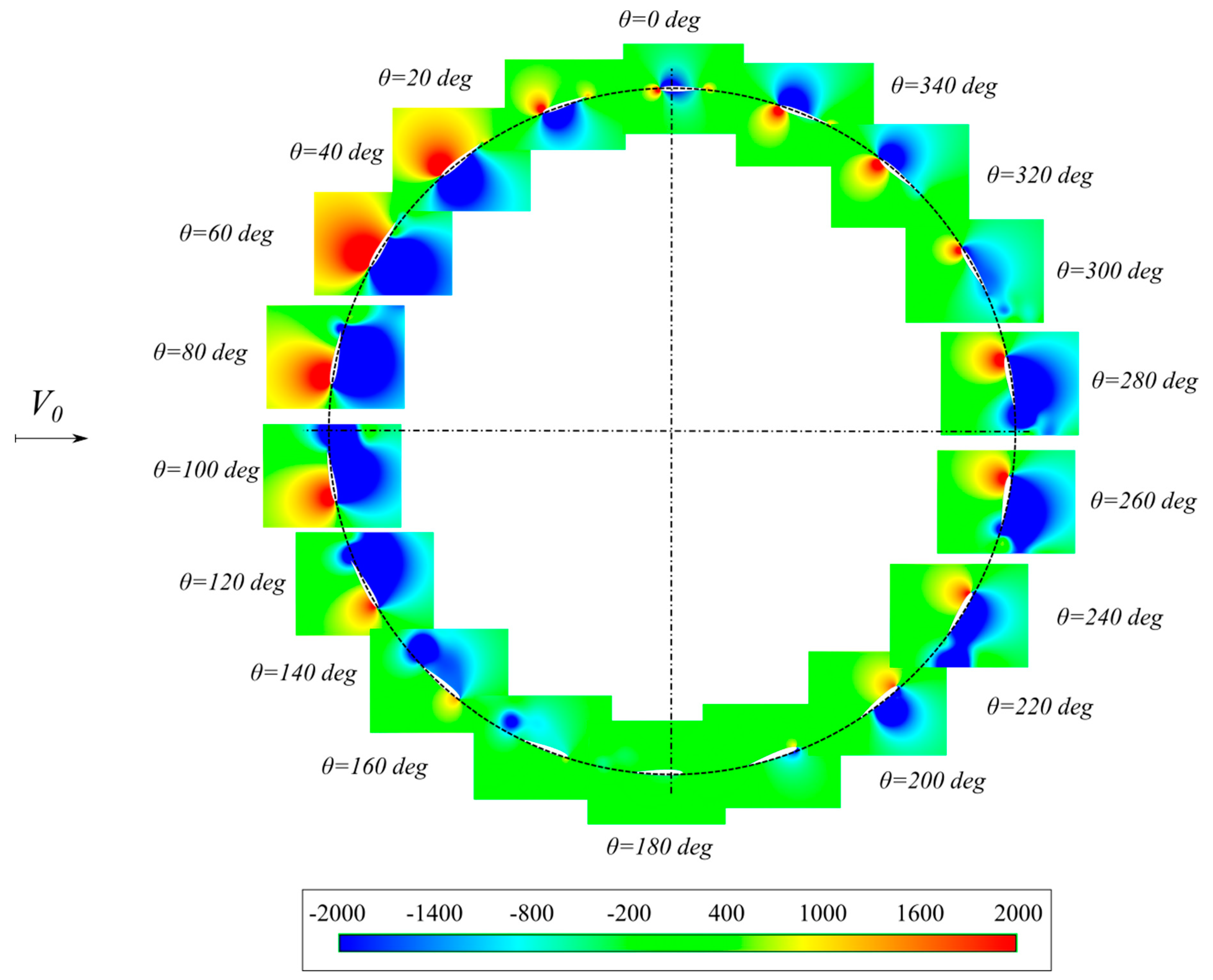
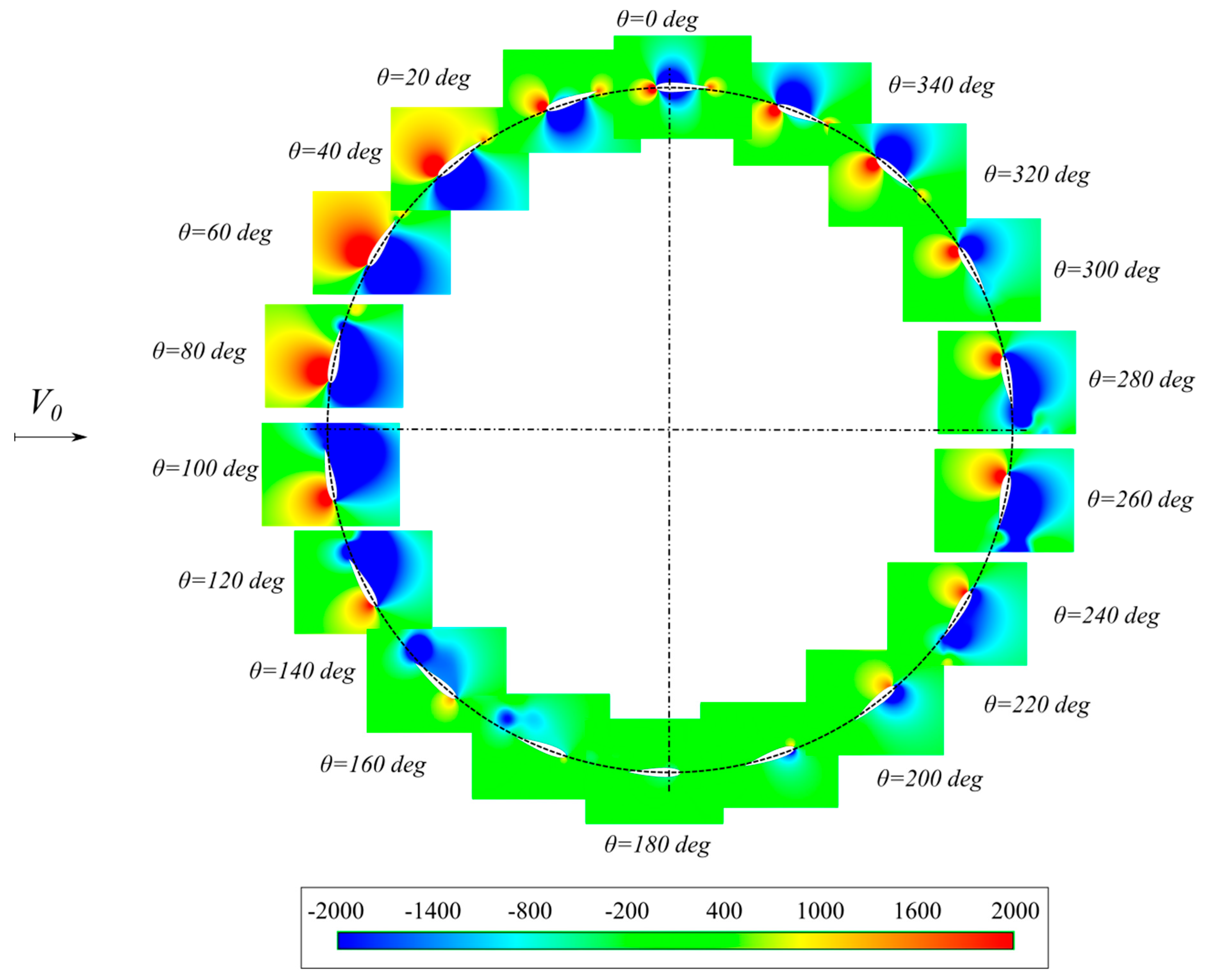
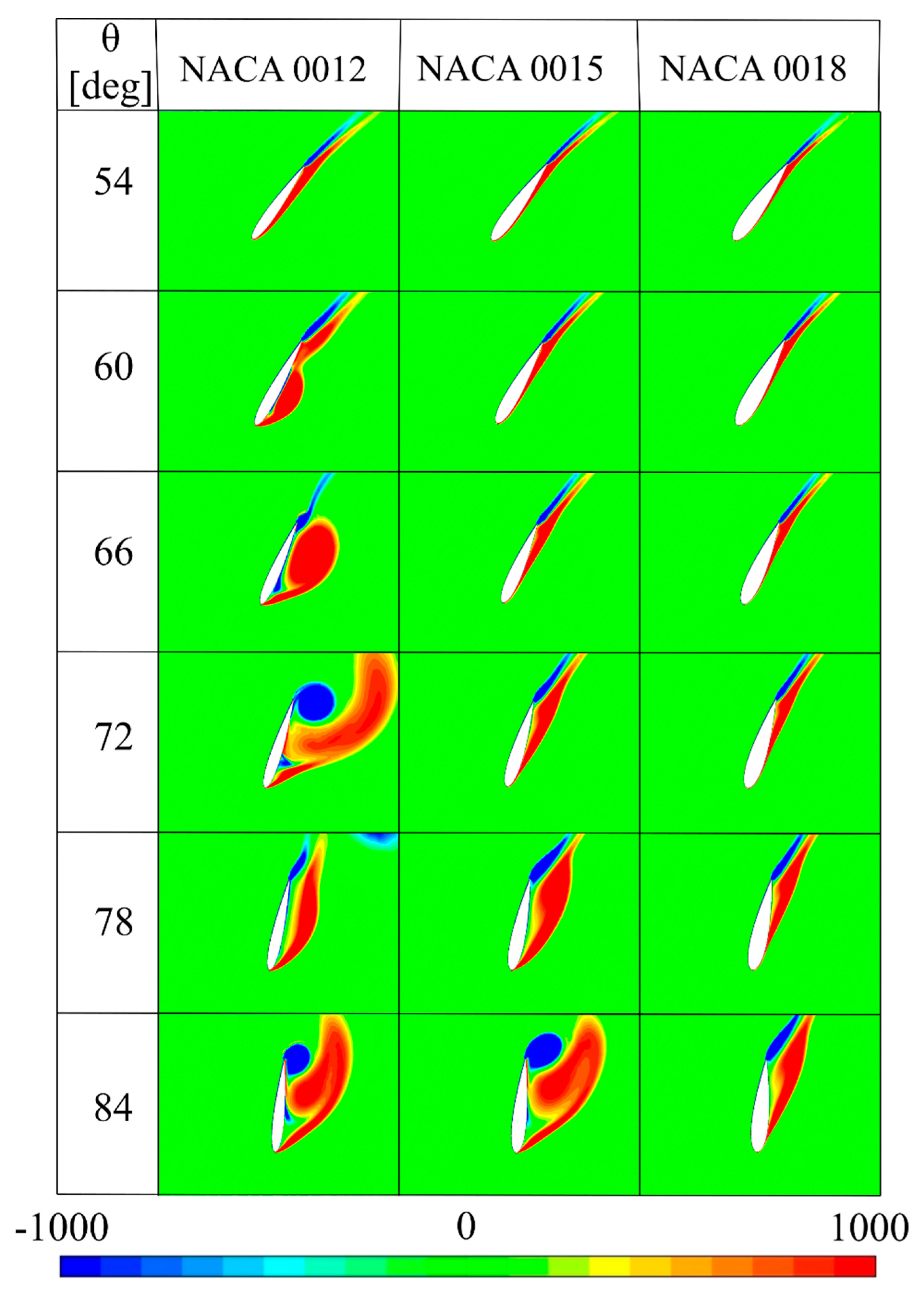
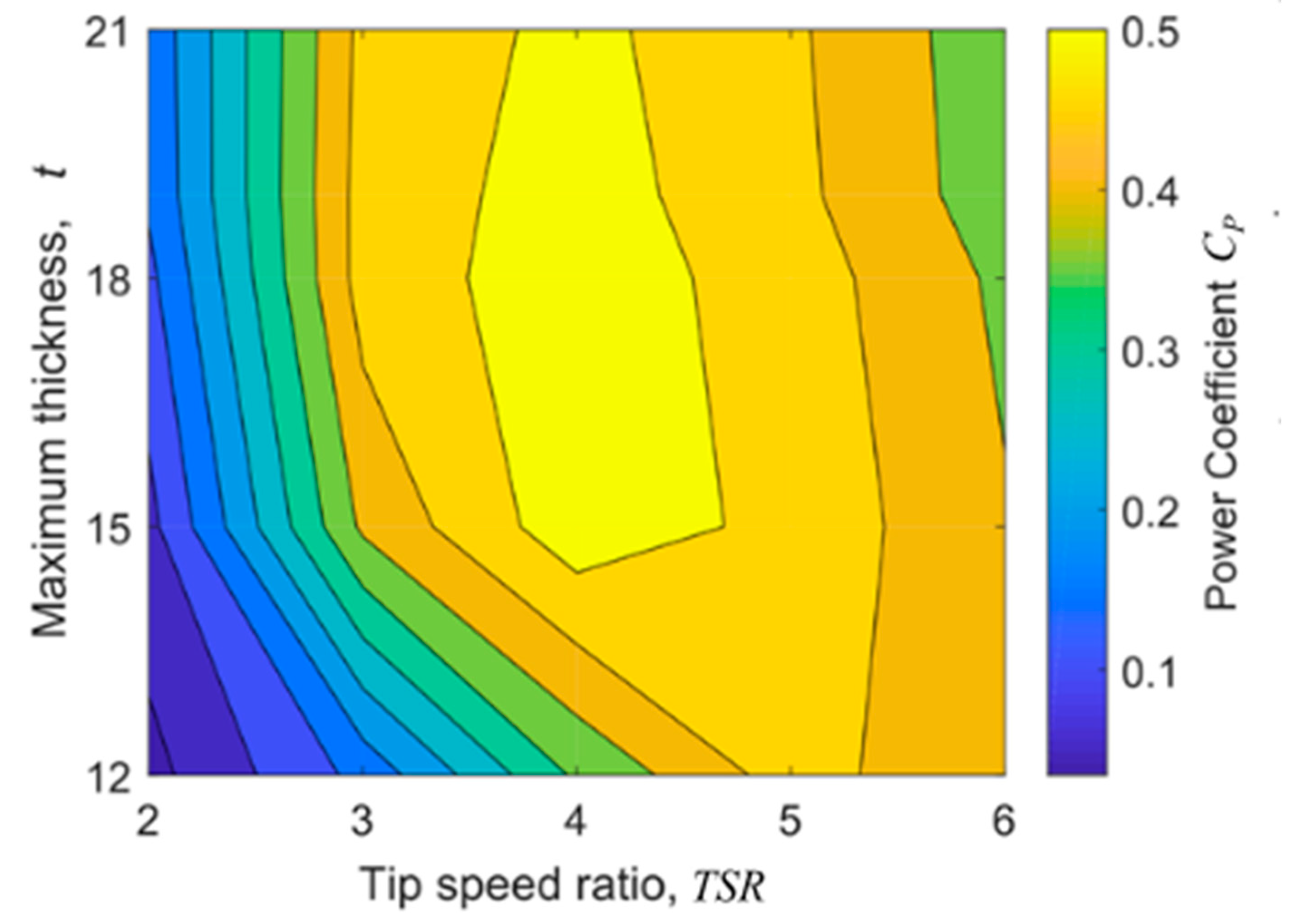
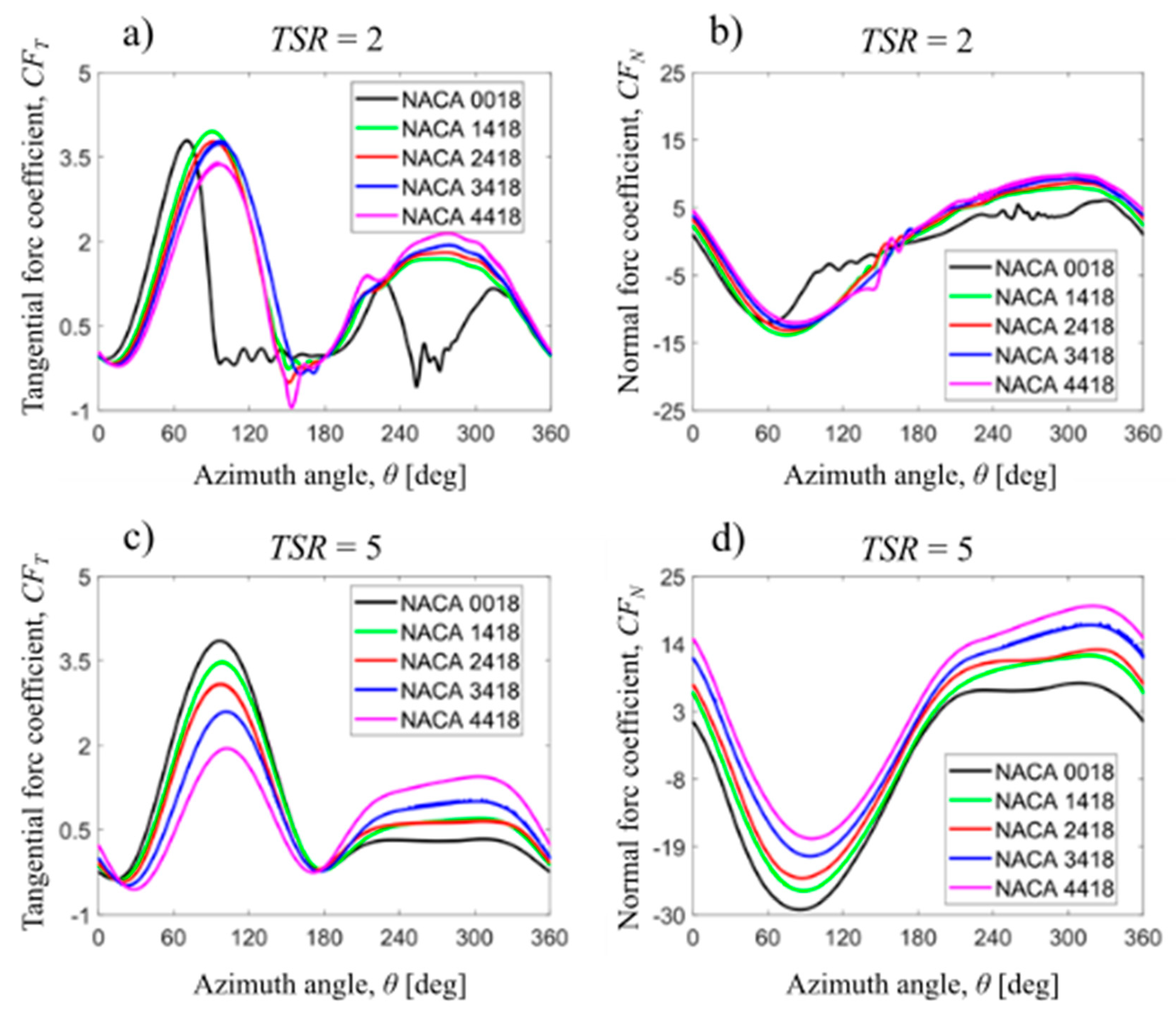

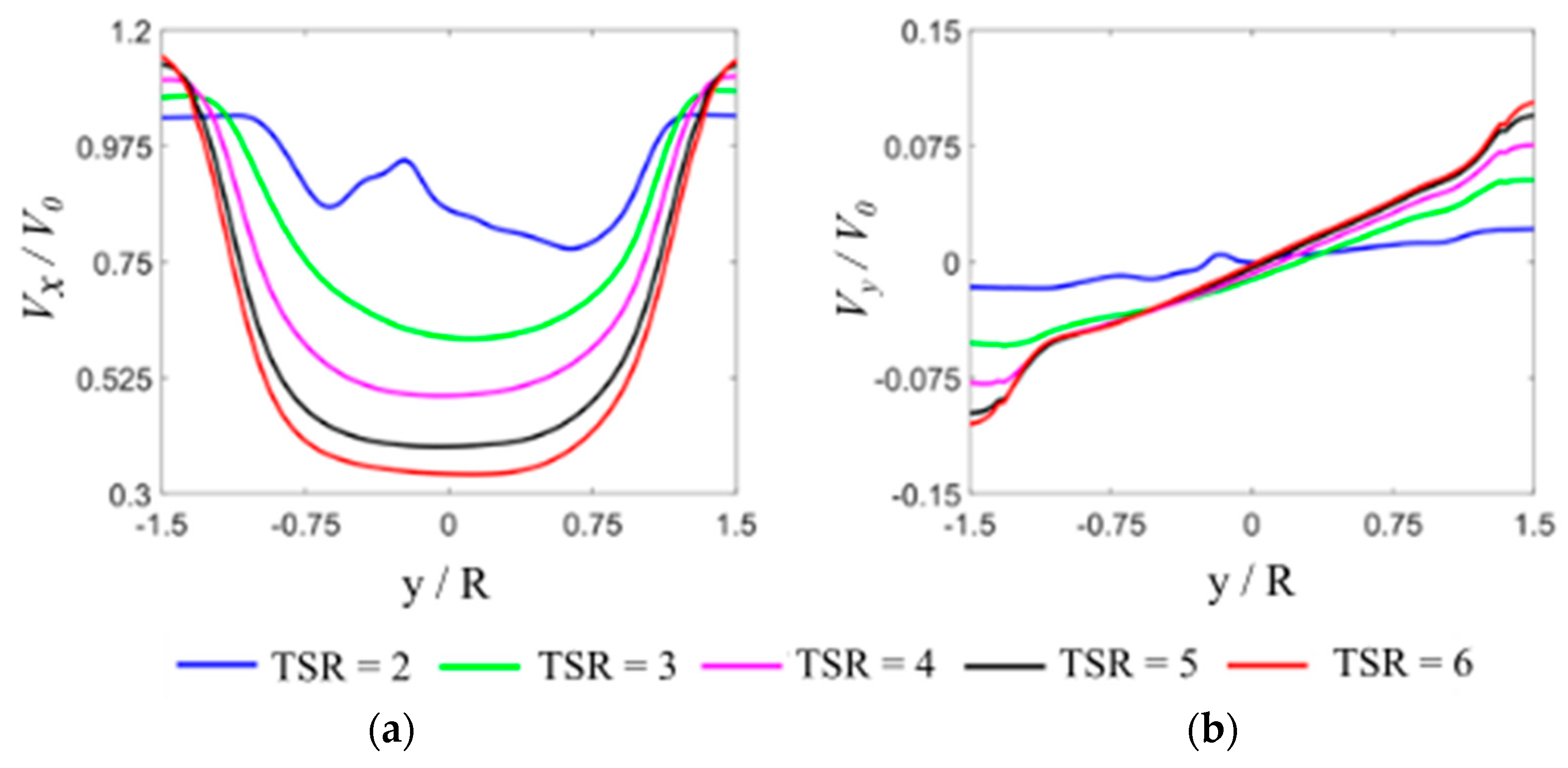
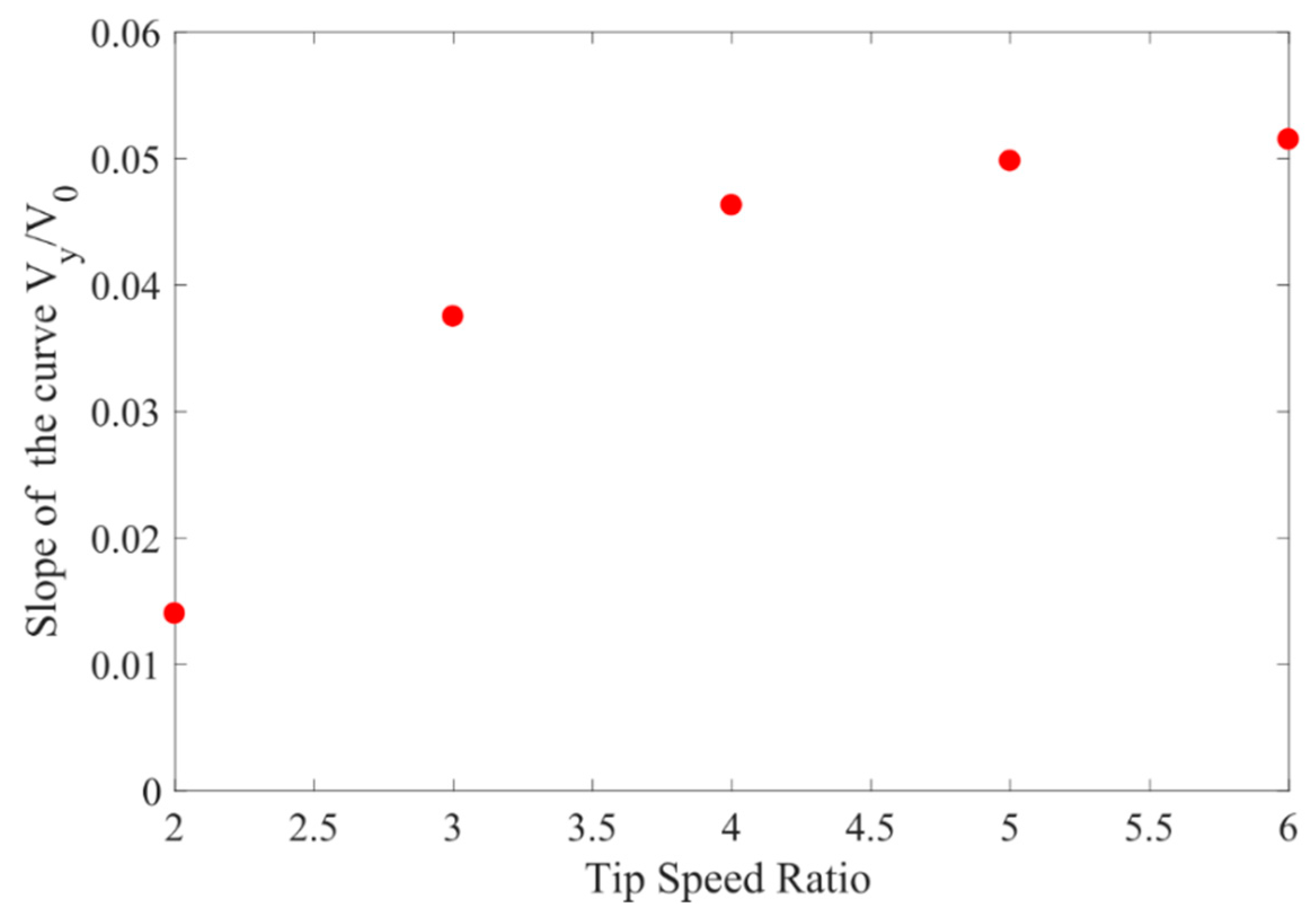
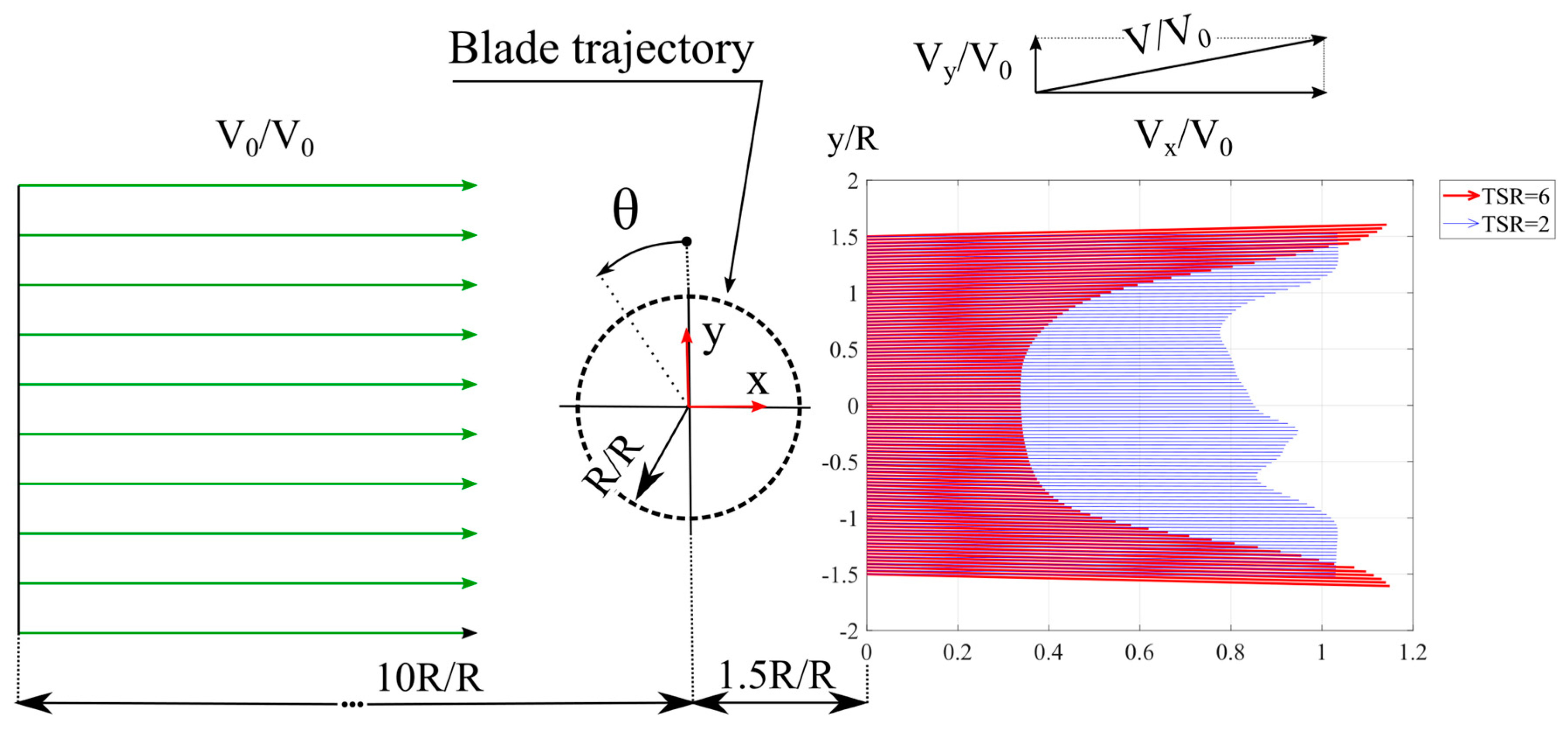
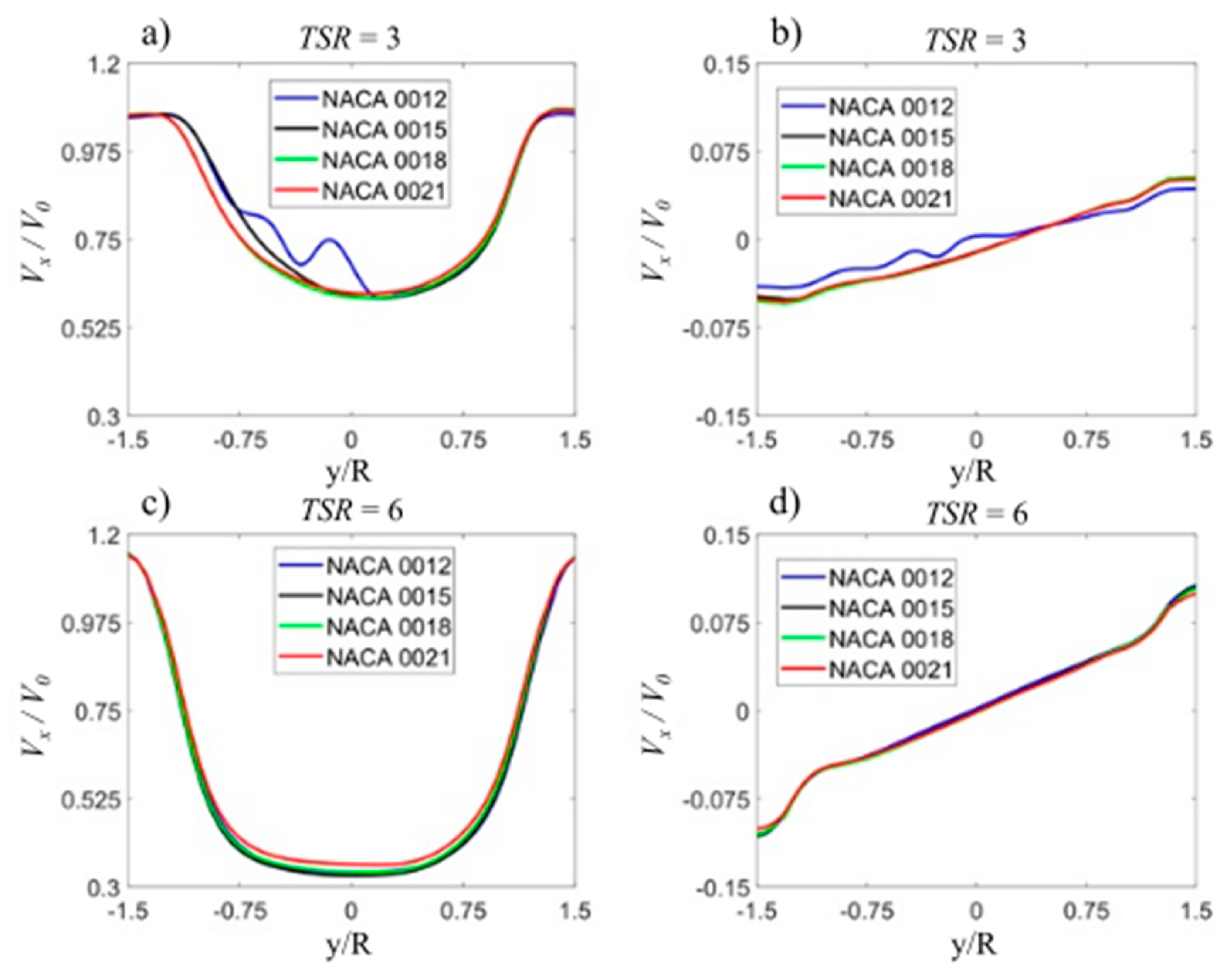
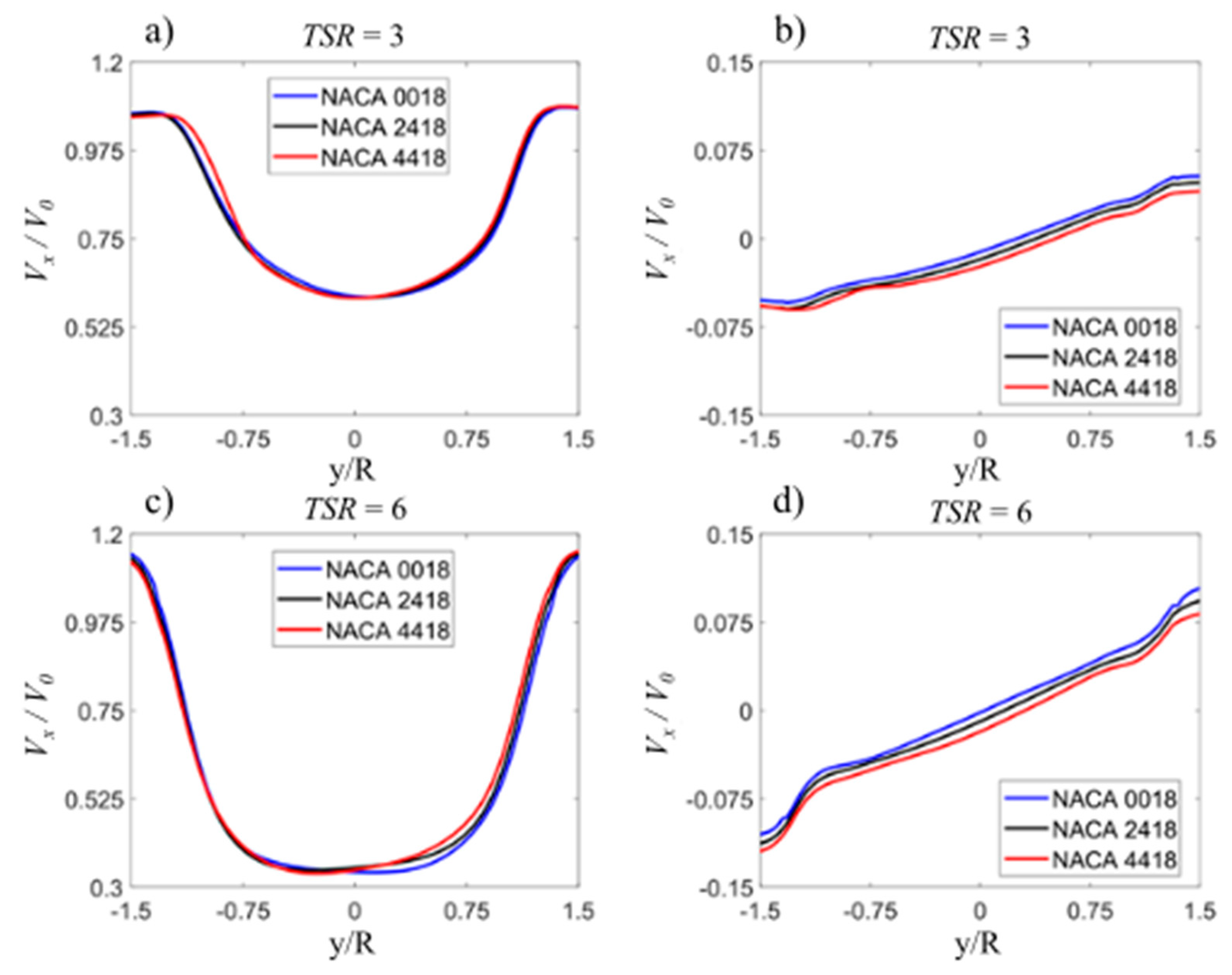
| Parameter | Value |
|---|---|
| Rotor radius, R | 8.84 [m] |
| Blade length | 12.9 [m] |
| Chord, c | 0.61 [m] |
| Airfoil type | NACA 0018 |
| Number of blades, B | 3 |
| Rotor solidity, σ = Bc/R | 0.2 |
© 2020 by the authors. Licensee MDPI, Basel, Switzerland. This article is an open access article distributed under the terms and conditions of the Creative Commons Attribution (CC BY) license (http://creativecommons.org/licenses/by/4.0/).
Share and Cite
Rogowski, K.; Hansen, M.O.L.; Bangga, G. Performance Analysis of a H-Darrieus Wind Turbine for a Series of 4-Digit NACA Airfoils. Energies 2020, 13, 3196. https://doi.org/10.3390/en13123196
Rogowski K, Hansen MOL, Bangga G. Performance Analysis of a H-Darrieus Wind Turbine for a Series of 4-Digit NACA Airfoils. Energies. 2020; 13(12):3196. https://doi.org/10.3390/en13123196
Chicago/Turabian StyleRogowski, Krzysztof, Martin Otto Laver Hansen, and Galih Bangga. 2020. "Performance Analysis of a H-Darrieus Wind Turbine for a Series of 4-Digit NACA Airfoils" Energies 13, no. 12: 3196. https://doi.org/10.3390/en13123196
APA StyleRogowski, K., Hansen, M. O. L., & Bangga, G. (2020). Performance Analysis of a H-Darrieus Wind Turbine for a Series of 4-Digit NACA Airfoils. Energies, 13(12), 3196. https://doi.org/10.3390/en13123196







